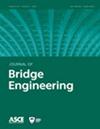Structural Behavior and Load Distribution Factor of a T-Girder Bridge with Various Truss Diaphragms
IF 3.5
2区 工程技术
Q2 ENGINEERING, CIVIL
引用次数: 0
Abstract
A diaphragm is an essential component of a T-girder bridge. Evaluating the influence of various truss diaphragms (TDs) on the structural behavior and load distribution factor of T-girder bridges assists in bridge design and strengthening. In this study, a series of experiments and simulations were conducted to investigate the strengthening effect of two types of TDs (i.e., triangle-TDs and K-TDs) based on a small-scale T-girder bridge model. Formulas for the flexural rigidity of the two types of TDs were proposed and verified by using rigid-joint girder methods, experiments, and simulations. Then, taking the K-TD as an example, the calculation method for the stiffness of the truss was analyzed and derived based on rigid-joint girder and graphic multiplication methods. The results showed that K-TDs had a better strengthening effect than triangle-TDs. The deflection and strain of the K-TD-strengthened T-girder bridge were reduced by 21% and 16%, respectively, compared with those of the triangle-TD-strengthened bridge. The formulas for flexural rigidity were proposed and used to calculate the load distribution factor. The maximum error of the calculated load distribution factor was 16% compared with the simulation and experimental results. Moreover, the calculation method for the stiffness of the K-TDs was analyzed and obtained.Practical ApplicationsDeterioration of multigirder bridges is getting worse due to the increasing traffic load and insufficient maintenance. Adding diaphragms to the existing bridges can improve the load distribution of multigirder bridges and reduce the maximum load of the girders. This work evaluated the influence of two types of truss diaphragms (triangle truss diaphragm and K truss diaphragm) on the load distribution of a T-girder bridge, and the results showed that the two types of truss diaphragms can reduce the maximum deflection and strain in the T-girder bridge effectively. The flexural rigidity formulas for the two types of truss diaphragm were proposed and proved to be accurate by comparing with experiments and finite-element methods. Moreover, the truss stiffness of the K truss diaphragm was derived by a graphic multiplication method. These formulas can be used by bridge engineers for new bridge designing or existing bridge strengthening in practical engineering.不同桁架隔板的t梁桥结构性能及荷载分配系数
横膈膜是t型梁桥的重要组成部分。评价不同桁架隔板对t梁桥结构性能和荷载分配系数的影响有助于桥梁的设计和加固。本研究基于小尺度t梁桥模型,通过一系列的试验和模拟,研究了两种类型的td(三角形td和k型td)的加固效果。提出了两种结构的抗弯刚度计算公式,并通过刚缝梁法、试验和仿真验证了公式的正确性。然后,以K-TD为例,分析推导了基于刚缝梁法和图形乘法法的桁架刚度计算方法。结果表明,k - td的强化效果优于三角td。与三角td加固t梁桥相比,k - td加固t梁桥的挠度和应变分别减小了21%和16%。提出了挠曲刚度计算公式,并用于计算荷载分配系数。计算得到的载荷分配系数与仿真和实验结果的最大误差为16%。分析并得出了K-TDs刚度的计算方法。实际应用由于交通荷载的增加和养护的不足,多梁桥的老化问题日益严重。在既有桥梁上增加横膈膜可以改善多梁桥的荷载分布,降低桥梁的最大荷载。研究了两种桁架隔板(三角形桁架隔板和K型桁架隔板)对t梁桥荷载分布的影响,结果表明,两种桁架隔板能有效减小t梁桥的最大挠度和应变。提出了两种桁架膜片的抗弯刚度计算公式,并与实验和有限元方法进行了比较,证明了公式的准确性。此外,采用图形乘法法推导了K桁架膜片的桁架刚度。这些公式可供桥梁工程师在实际工程中进行新桥设计或既有桥梁加固时使用。
本文章由计算机程序翻译,如有差异,请以英文原文为准。
求助全文
约1分钟内获得全文
求助全文
来源期刊

Journal of Bridge Engineering
工程技术-工程:土木
CiteScore
6.30
自引率
5.60%
发文量
166
审稿时长
6 months
期刊介绍:
The Journal of Bridge Engineering publishes papers about all aspects of the art and science of bridge engineering. The journal publishes research that advances the practice and profession of bridge engineering and papers about issues, projects, materials, design, fabrication, construction, inspection, evaluation, safety, performance, management, retrofitting, rehabilitation, repair, and demolition.
 求助内容:
求助内容: 应助结果提醒方式:
应助结果提醒方式:


